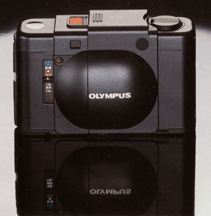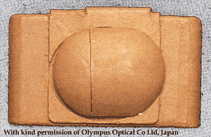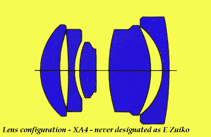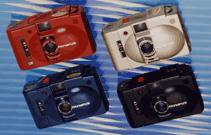
the olympus xa series - concept and design
copyright the olympus circle

the olympus xa series - concept and design copyright the olympus circle |

Olympus XA Capsule Camera |
As Editor of Quest, Magazine of The Olympus Circle I write a Centrepiece article for every quarterly issue. This is from Quest Issue 1.~~~~~ Without doubt one of the most popular series of full-frame 35mm cameras from the Olympus stable. On general release from 1979 and continually developed for just under a decade to broaden its appeal the XA series remains a firm favourite with many photographers. Its basic design concept of case-less and cap-less has been copied by virtually every other manufacturer and the latest lens-shutter cameras such as the Olympus Mju still display these attributes. Studies of Olympus products, especially the viewfinder Pen series, show a progression from the original concept - a fully manual camera - to a fixed focus semi-auto version to a zone focus semi-auto and then further development of both manual and semi-auto versions. This pattern seems to hold good in the XA development, though not quite in this order. This might be interpreted as a ‘cheapening’ of the original design - compare the XA to the XA1 and you’ll see what I mean - but there is more to it than this. One lesson learned by Mr Maitani in the early years of the viewfinder Pen was that the semi-auto versions far outsold the complex manual version. Although he had the semi-auto version of the viewfinder Pen in mind from the start, he designed the Pen initially as a manual camera. From a designers viewpoint this makes sense – design criteria first followed by sales criteria. It seems the XA series follows this rationale. Before looking at XA development let us acquaint ourselves with some of Yoshihisa Maitani’s philosophies. From his first days with Olympus he recognised that many of Japans products, including cameras were straight copies of European or American goods. He had no wish to join that particular bandwagon; he thought it demeaning that Japanese designers relied so heavily on plagiarism. So it was with the Pen and all that followed, he designed from scratch, to his own criteria, disregarding fashion and/or pre-conception, endeavouring to create form in its own merit. With the XA series this was even harder as it could not be seen as a regurgitated Pen or OM. There was other outside factors too, which influenced his design criteria. 1975 saw Konica’s C35EF storming the marketplace. The very capable Olympus Trip introduced in 1968 was unpopular in America as it was considered too large and had no built-in flash. SLR sales were mainly ‘restricted’ to established photographers, comfortable with the knobs and dials. Men and women alike were apprehensive about using what appeared to be ‘precision’ cameras. ‘Across the family’ usage was key. As early as 1975 Mr Maitani put his thinking cap on. After the enormous success of the Olympus Pen followed by the incomparable OM system one might think Mr Maitani might sit on his laurels. Not so. As the OM 2 hit the marketplace the mind of Yoshihisa Maitani was already seeking out the direction of the next generation of cameras. He led a brainstorming session with the design team in an effort to get them to think along different lines. The attributes of both SLR and lens shutter cameras were discussed, as well as their disadvantages as the chief designer challenged his team. While SLR’s were highly capable picture taking machines many women, and he suspected, men too were simply discouraged from using them, as they were too complex. Size was also a major factor, especially for women, whom when dressed up for an occasion were unlikely to sling a SLR around their necks. Lens shutter cameras also had drawbacks, for although they were inherently smaller they too could be complex, had cases to protect them and then lens caps, all to be found a home whilst trying to take an impromptu photo. Gradually his team started to see his thinking – full-frame, small, neat, pocketable and without case or lens cap and the picture taking qualities of a SLR – a veritable challenge. With firm design objectives in mind Mr Maitani challenged himself, his design team and the lens makers at Olympus. |

Yoshihisa Maitani's XA clay model |
With his own thoughts in mind Mr Maitani, at home and late into the night sculpted models of his camera ideas from clay. This went on for months. Model after model was made, examined for hours then kept for comparison with his next design before being scrapped. Slowly his ideas took positive forms, but knowing he had a very long way to go he kept them to himself, for now. When the final clay model was finished it looked little like a conventional camera. It was a 40mm thin ‘block’ no bigger than the Pen half-frame, smooth and rounded with a slight bump of the front and seemingly without a lens. After several more sessions with the team and making sure its members knew the pressures both he and management were applying, he showed his model to a few team members at a time. He was gauging feedback on the unusual design and attributes of his model. Satisfied that his model had suitably impressed and inspired the team, the development programme stepped up a gear. Now came the really hard work, painstaking design to ensure the new concept camera kept within its original dimensions. Just like the Pen, one major problem was the lens, but this time it was not cost that set the limitations, but size. Visiting his colleague Mr Hayamizu in the Lens division, the same design engineer to whom Mr Maitani turned to produce the Pen lens back in 1959, he talked about his ideas, particularly the ideal thickness of the camera, set at 40mm. His colleague promised to look at the various configurations to see what lens, if any could be set in such a thin camera. Illustrations: Clay sculptures - page 10 the XA, above left XA2, right A11 detachable flash. By kind permission of Olympus Optical Co Ltd, Japan.] After many weeks Mr Hayamizu called his colleague over to the Lens division. News was not good. Every conceivable configuration had been tried and each failed the basic criteria – slimness. Undaunted Mr Maitani produced two clay models and laid them on the table. The first was a strange capsule shape with a flattish dome on the front. The second was the same model but the dome seemed to stick out much further. Mr Maitani explained that if Olympus could make a camera as slim as model one people would be happy to carry it around in their pockets. The model with the larger protrusion was less appealing, less elegant with a definite sense of thickness. Comparing the two it was obvious to Mr Hayamizu which was preferable but Maitani pressed on explaining that the difference in thickness was a mere 5mm, but in a camera so small and slim 5mm becomes huge. It was ironical that the 5mm difference was almost the same 4mm [too thick] that Mr Hayamizu had found trying to configure a slim 35mm focal length lens. In other words the best lens configuration he had designed could fit the thicker of the two models, but not the slimmer one, the one Mr Maitani said was the way forward. And to add to the problems the sliding front barrier of the new model imposed a further restriction. The lens must not move during focussing. After a few minutes of silence Mr Hayamizu agreed, reluctantly, to go back to the drawing board. |

And his model of the XA2 series |
Your narrator cannot explain the technicalities of lens making, but it seems that during development of the OM series every single lens was redesigned to make them smaller and lighter. Much effort had been expended in reducing the length of the lens tube of telephoto lenses to match the compact OM1 lines. To achieve this a retro-focus configuration is used, but no one had ever applied this rationale to a wide-angle lens. To work it needed a reverse retro-focus configuration – completely new territory for the Olympus lens design team. But there was much more to it than this, there were compensations to be made for peripheral focus and a host of variables to deal with curvature, focal length, aberrations, spacing; the list goes on. Slowly and laboriously the variables were fed into the computer for weeks on end until, at last, one set met the criteria and the worlds first reverse retro-focus wide-angle lens was within reach. At an astonishing 33.6 mm from front to back it would certainly fit the design shell of 40mm. The remaining problem of a non-moving front element was resolved by moving the inner lens group only. When Mr Hayamizu told Mr Maitani both men were ecstatic, one for seemingly achieving the impossible and the other for not having to abandon what he knew was a winning design. Needless to say it did not stop here. There was a list of design objectives still to be met. The tiny shutter needed small but powerful magnets to achieve Mr Maitani’s specification of 1/500th to 10 seconds exposure time. The newly produced OM2 provided one of the two magnets required but the other proved elusive. It was a rare earth magnet discovered by Mr Maitani himself that solved this set of problems. |

Lens configuration XA4 |
Next came the shutter release button. He wanted a button that would release on the gentlest touch. The designer knew the consequences of a mechanical button – camera shake, especially with ultra-lightweight cameras – so a new concept was required. At first he thought of a heat sensitive pad, but this was rejected. Then an electrical sensing switch reading current on the skin, again dismissed. Eventually after protracted searches of new technologies a ‘pressure sensitive conductor element’ was found, and when built into the camera provided a shutter release as light as a feather. The camera has audio and visual warnings built into the self-timer unit and certain checking functions. A red LED and a piezoelectric ceramic vibrator, both ideas directly from Mr Maitani, provided this functionality. The circuit board controlling all camera functions was a wonder of miniaturisation. The barrier door, so central to the design concept, also proved extremely tricky to mass-produce. Try as they might a perfect fit around the domed part of the cover could not be achieved in the pressing shop with traditional moulding techniques. This was a major threat to camera production. So much so that one of the company’s top toolmakers was sent away from the factory at Suwa and told not to return until he had the answer. After a week at headquarters he had the solution. By late 1978 at Photokina, Germany, Olympus showed the world a prototype XA. But Mr Maitani was not finished. Afterwards he took the long way home via Italy and other European cultural capitals exposing many rolls of film with the prototype XA. As a photographer he wanted to evaluate his brainchild. Almost inevitably he found slight errors and these were redressed when he returned to Japan. In April 1979 the XA went on general release. It was stunningly popular and regardless of how many times the Suwa production line was accelerated, Olympus could never satisfy demand. |

The first 4 colours of XA2 series. Photo copyright Tony Hurst. |
Considering that Konica released its C35AF camera in 1977, effectively starting the compact camera auto-focus race and having the ‘drop’ on Olympus, the manual focus XA’s high specification, superb design and quality build was a remarkable testimony. No auto-focus derivative of the XA was ever produced, but the XA2 with zone focussing, the XA3 with DX coding, the XA1 with fixed focus lens and the XA4’s remarkable macro facility completed the line-up. By the time the XA4 was released sales were waning and for all its attributes, especially the macro capability and sophisticated lens configuration it was, in the overall scheme of things, expensive. From a collectors stand point the XA series has much to offer. As well as the four series models Olympus produced coloured versions of the XA2 and XA3, and a clear version, fitted data-backs to XA3’s for the home market and offered a range of attachable flashes; A9M, A1L, A11 and A16 with a special macro flash attachment for use on the A11 when used on the XA4 for macro work. |

Urban white XA2 - quite rare |
PRICE INDICATORS: The following are based on mint minus to boxed examples, though there are many bargains to be had, especially XA2’s. XA rangefinder with A11 £70 - £90 XA rangefinder with A16 £90 - £110 XA2 zone focus black with A11 £30 - £45 XA2 zone focus red with matching A11 £60 - £85 XA2 zone focus blue with matching A11 £65 - £90 XA2 zone focus white with matching A11 £75 - £105 XA3 zone focus with DX coding black with A11 £45 - £55 XA3 zone focus with DX coding red with matching A11 £75 - £100 XA3 zone focus with DX coding body only, clear £120 - £150 XA3 zone focus with DX coding black with A11and date-back £65 - £85 XA4 complex focus, DX coding, A11 and Macro attachment £120 - £160 XA1 fixed focus, restricted ASA with A9M £40 - £60 A11 flash - £25.00, A16 - £35, A1L - £25, A9M - £20, Macro attachment - £30 Future Centrpiece articles on the XA series will cover more technical issues about each model.
|
|
|
|
HOME |
INTRO |
BOOKS |
OLYMPUS CIRCLE |
QUEST |
TOC MEMBERS |
GALLERIES
|
| Posted 2004/12/12 | Copyright © 2004 John Foster |